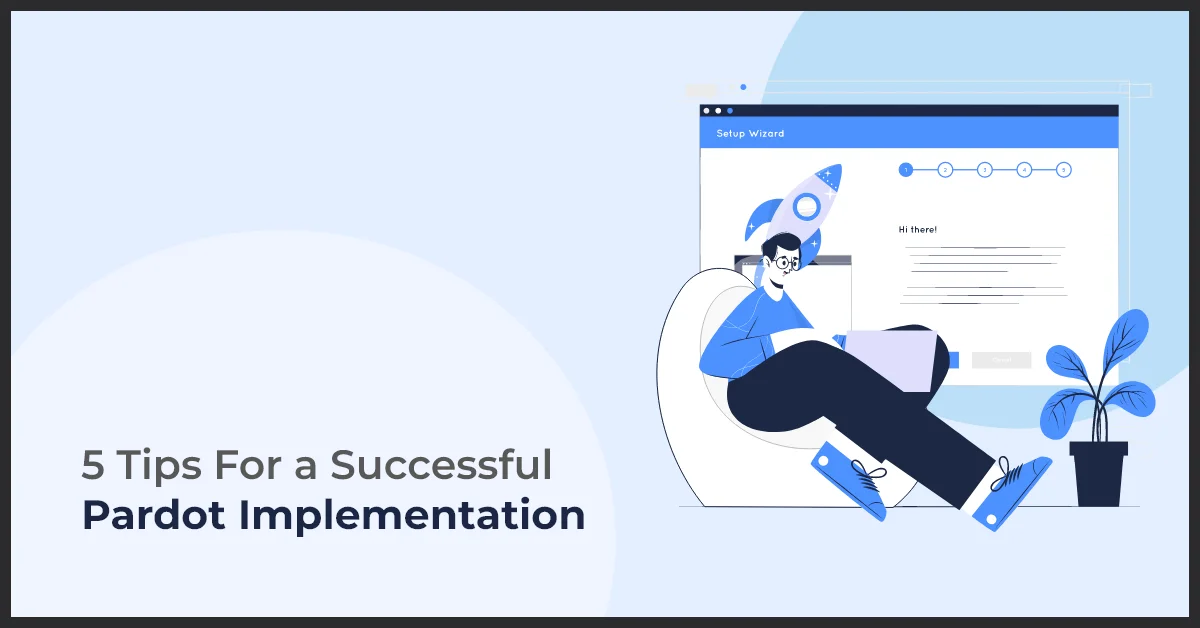5 Tips For a Successful Pardot Implementation

Published on: January 3, 2020
Updated on: October 15, 2024
1847 Views
- Pardot
10 min read
Are you looking for a game-changer in your marketing efforts? Look no further than Pardot implementation. In today's competitive business landscape, implementing Pardot, a powerful marketing automation tool, can unlock a world of possibilities for your company.
Pardot implementation refers to the process of seamlessly integrating Pardot into your business operations. It enables you to streamline and automate various marketing activities, such as lead generation, email marketing, campaign management, and data analysis, all in one centralized platform.
The benefits of Pardot implementation are numerous. Firstly, it enhances your overall marketing efficiency by automating repetitive tasks, allowing your team to focus on strategic initiatives. By automating lead nurturing, scoring, and qualification, Pardot ensures that your marketing and sales teams are aligned, leading to higher conversion rates and increased revenue.
Moreover, Pardot provides advanced reporting and analytics capabilities, enabling you to gain valuable insights into your marketing campaigns' performance. With detailed metrics, you can fine-tune your strategies, optimize your efforts, and drive better results.
In addition, Pardot's intuitive user interface and customizable features make it easy to tailor the platform to your specific business needs. Whether you are a small startup or a large enterprise, Pardot's scalability and flexibility empower you to adapt and grow your marketing efforts seamlessly.
Don't miss out on the transformative power of Pardot implementation. Invest in this cutting-edge marketing automation tool to accelerate your business success and stay ahead of the competition.
Understanding Pardot and its Features
One of the key aspects of successful Pardot implementation is understanding its features and capabilities. Pardot is a powerful marketing automation tool that can streamline and enhance your marketing and sales efforts. Below, we will provide an overview of Pardot's key features, explain how it helps in marketing and sales automation, and discuss the advantages of integrating Pardot with Salesforce.
Overview of Pardot and its key features
Pardot is a comprehensive marketing automation platform that enables businesses to generate more leads, nurture prospects, and accelerate the sales cycle. It offers a range of features designed to streamline marketing and sales processes and drive better results. Some of the key features of Pardot include:
- Lead Generation: Pardot allows you to capture leads through various channels, such as forms on your website, landing pages, and social media.
- Lead Nurturing: With Pardot, you can automate personalized email nurturing campaigns and engage prospects with targeted content based on their behavior and interests.
- Scoring and Grading: Pardot enables you to assign scores to leads based on their engagement level and grade them based on their fit with your ideal customer profile.
- ROI Reporting: Pardot provides detailed analytics and reporting on marketing campaigns, helping you measure the return on investment and make data-driven decisions.
How Pardot helps in marketing and sales automation
Pardot plays a crucial role in automating marketing and sales processes, allowing teams to streamline their efforts and focus on high-value activities.
By leveraging Pardot's automation capabilities, businesses can:
- Save time and effort by automating repetitive tasks, such as lead nurturing, email campaigns, and lead assignment.
- Improve lead quality and conversion rates by nurturing prospects with personalized and timely content, increasing engagement, and moving them through the sales funnel more efficiently.
- Enhance collaboration between marketing and sales teams by providing a centralized platform for lead management, lead scoring, and campaign tracking, ensuring alignment and better communication.
Pro Tip: Use Pardot to automate repetitive tasks like lead nurturing, email campaigns, and lead assignments, saving time and improving efficiency. Its centralized platform boosts collaboration between marketing and sales, while personalized, timely content nurtures leads, enhances engagement, and drives higher conversion rates.
Integration with Salesforce and its advantages
Pardot is a Salesforce product, and its seamless integration with Salesforce CRM offers several advantages for businesses:
- Unified Data: Integration between Pardot and Salesforce ensures that all marketing and sales data is synced and unified, providing a holistic view of your prospects and customers.
- Sales and Marketing Alignment: By integrating Pardot with Salesforce, marketing and sales teams can closely collaborate and share information, ensuring smoother lead handoff and better alignment between the two departments.
- Advanced Reporting and Analytics: With Pardot and Salesforce integrated, you can leverage powerful reporting and analytics capabilities to track the effectiveness of your marketing campaigns, measure ROI, and make data-driven decisions.
- Campaign ROI Attribution: Integration allows you to track the contribution of each marketing campaign to closed deals in Salesforce, providing a clear understanding of campaign effectiveness and ROI.
Planning for Pardot Implementation
Implementing Pardot is an exciting endeavor that can transform the way you engage with your customers and drive business growth. However, before diving in headfirst, it's crucial to have a solid plan in place. Proper planning sets the foundation for a successful Pardot implementation and ensures that you can make the most out of this powerful marketing automation tool.
Importance of proper planning before implementing Pardot
Without proper planning, your Pardot implementation may fall short of expectations or encounter unnecessary roadblocks. Planning allows you to assess your current marketing strategies, identify pain points, and determine how Pardot can address those challenges. By understanding your specific needs and aligning Pardot's features with your objectives, you can maximize the platform's potential and achieve optimal results.
Identifying business goals and objectives
Before embarking on a Pardot implementation, it's crucial to clearly define your business goals and objectives. This step helps you identify what you want to achieve with Pardot, whether it's generating more leads, increasing conversion rates, or improving customer engagement. By outlining these goals, you can design a tailored Pardot strategy that aligns with your unique business needs, ensuring that your implementation is purposeful and effective.
Developing a roadmap for Pardot implementation
A well-defined roadmap is essential for a smooth Pardot implementation. Start by identifying key milestones and deadlines, breaking down the implementation process into manageable phases. Assign responsibilities to team members to ensure a collaborative approach. Additionally, consider any potential challenges or roadblocks that may arise during implementation and develop contingency plans. By creating a roadmap, you can navigate the implementation process with clarity and efficiency.
Crawl, Walk, and Run; this is how it exactly goes when working on Pardot Implementation!!
Do you aspire to get the maximum ROI out of your Pardot implementation? Well, everyone does, it's a huge investment in terms of budget and time after all. But the bitter truth is, not all companies who invest in implementing marketing automation meet success. You need to develop an implementation strategy that is pragmatic and can get you off the ground with Pardot quickly.
Considering our own Pardot implementation experience with our clients, we are writing this post hoping it will help Pardot users and aspirants.
Some Worth-Knowing Marketing Automation Stats
- Nearly 50% of marketers admit that they have not been successful in implementing automated email marketing campaigns. - “Marketing Automation Trends for Success”
- 27% of marketing influencers find Marketing Automation/Email/CRM challenging to utilize. - “Marketing Technology Utilization Survey”
- Over 15% of marketers still find creating automation and integration as the biggest challenges with any automation tool. - “Marketing Automation Challenges Report 2019”
Here’s What You Need To Ensure To Make Your Pardot Implementation A Success
1. Identify & Define your Automation Processes
Working with vague or undefined processes while Pardot implementation can drag you into the rabbit hole. The first and foremost requirement for a successful Pardot implementation is - having clear and defined processes.
You can’t expect success until you understand what you want to improve with your automation tool. Do a health check-up of your current marketing and sales efforts and ask yourself the following questions:
- How successful are your sales engagements? How can you improve them to get better qualifying leads?
- Is your website generating enough leads? If no, how can you improve on this?
- Evaluation of your marketing KPIs, and how can you further improve them?
You better have a clear blueprint about the processes you want to automate, but do not rush for it. Define your process, do its IRL testing with humans, and see the results. If you find it fit to roll only, then you should automate it.
Pro Tip: Here’s What You Need To Ensure To Make Your Pardot Implementation A Success
2. Plan For Enough Content Assets
68% of successful marketers give credit to lead scoring based on content and engagement for experiencing improved revenue in their organizations- The Lenskold and Pedowitz Groups.
Ignoring the significance of required content (both in terms of quality & quantity) could be a big hurdle in any marketing automation practice - Pardot implementation is no different. Consider the example of the 'Drip nurturing email marketing campaign' - it requires a large volume of content. If you do not create enough content, you won't reach the goals you have set.
Develop enough content assets, including blogs, Whitepapers, checklists, guides, infographics, etc. that could be used in different campaigns to engage with your audience.
3. Outline Clear Ownership and Align the teams
Whom does the marketing automation tool belong to? Marketing, IT, or Sales department? Actually, all have a role to play and the success of your Pardot implementation depends on all. Align all your in-house teams and ensure their expertise in handling various Pardot processes. Defining clear responsibility will be way more helpful in implementing your automation tool. In case your team lacks knowledge in marketing automation tools, you can look forward to hiring professional services from Pardot Consulting agencies to bridge the gap.
4. Be Prepared to face Technical Implications challenges.
Pardot, just like other technology products you use requires technical resources to ensure success with it. Whether you like it or not, you need to have technical resources lined up to handle the technical implementation challenges that will come along by its nature. Activities like integration with your stack, building and managing assets will require technical expertise. If you do not have in house resources hire an expert agency to help with the technical setup.
Make sure the technical issues arising from your Pardot implementation are well documented for future references and maintain technical architecture documentation from day one. With growing Martech stack around your Pardot instance, you will need to refer and build this documentation over time.
5. Sow the Seeds For Post Implementation Support
⅔ of the companies fail to leverage the lead nurturing capabilities of marketing automation tools because of a lack of resources for post-implementation support. Make sure you have a resource plan and budget in place to have a team that can run Pardot operations and scales when the time comes. Though once set up you can expect the campaigns to run in an automated way you still need to orchestrate the automation. Make sure you have resources that are able to design, build, launch and manage campaigns in Pardot to drive the best results. Periodic training for the team on best practices should also be an integral part of your Pardot success plan.
There you go!!
Key Takeaways
- Pardot implementation can significantly enhance marketing efforts by automating tasks and improving efficiency.
- The platform provides lead generation, nurturing, scoring, and detailed ROI reporting features.
- Integration with Salesforce allows for unified data and improved collaboration between marketing and sales teams.
- Proper planning is crucial for successful Pardot implementation, including defining business goals and developing a clear roadmap.
- Clear ownership and team alignment are essential for effectively using Pardot across departments.
- Adequate technical resources and post-implementation support are necessary to address challenges and maximize ROI.
- Preparing content assets and defining automation processes can lead to better marketing outcomes.
Save yourself some time by preparing these things before starting with the Pardot implementation. However, having a partner to assist you in Pardot implementation could be a sound bet. You can reach out to our Pardot expert team to know more about ongoing & proactive support. Please write us an email at info@growthnatives.com.
Frequently Asked Questions
Pardot implementation refers to the setup and configuration of Pardot, Salesforce’s B2B marketing automation tool. This includes integrating it with Salesforce CRM, configuring lead generation, setting up email campaigns, lead scoring, and creating automation rules.
Avoid common mistakes such as not cleaning your data before importing, ignoring proper integration with Salesforce, skipping user training, failing to define clear goals, and not setting up lead scoring and nurturing effectively from the beginning.
Top challenges include data migration, Salesforce integration complexities, aligning marketing and sales processes, ensuring user adoption, and configuring automation and lead scoring according to business needs.
Benefits include streamlined lead management, enhanced marketing automation, better lead scoring and nurturing, improved alignment between sales and marketing teams, increased campaign ROI, and detailed reporting for data-driven decisions.
Optimize Pardot by regularly updating lead scoring, creating segmented lists for targeted campaigns, integrating with other tools like Salesforce, A/B testing emails, analyzing campaign performance, and refining automation workflows.



